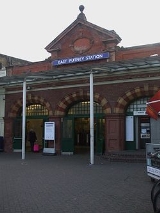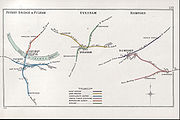
East Putney tube station
Encyclopedia
East Putney is a London Underground
station on the branch of the District line
. It is between to the north, and to the south. The station is on Upper Richmond Road (A205)
. It is on the boundary of Travelcard Zone 2
and Travelcard Zone 3
(MDR, now the District Line) on 3 June 1889 on an extension from Putney Bridge station to . The extension was built by the London and South Western Railway
(L&SWR) which, starting on 1 July 1889, ran its own trains over the line via an eastward-facing loop that joins the to mainline.
The section of the District Line from Putney Bridge to Wimbledon was the last part of the line to be converted from steam operation to electric. Electric trains began running on 27 August 1905.
Mainline services through East Putney were ended by the Southern Railway
(successor to the L&SWR) on 4 May 1941, although the line remained in British Rail
ownership until 1 April 1994 when it was sold to London Underground for the nominal sum of £1. Until the sale, the station was branded as a British Rail station.
 The junction between the District Line tracks and what is now the National Rail
The junction between the District Line tracks and what is now the National Rail
loop to the main line is immediately to the south of the station. Two pairs of tracks (one pair for each operator) run through the station giving it a narrow Y-shaped arrangement with a shared central island platform and two separate platforms across the tracks for opposite directions. The street-level station entrance and buildings lie between the two arms of the Y. The isolated National Rail platform is disused and overgrown, but the National Rail platform on the central island is in working order. Although it is not served by regular trains it is very occasionally used for terminating services from Wimbledon in connection with engineering works. A barrier has been built on the central island platform across the part of the platform that forks off to the north-east and forms the right arm of the Y.
The station has four staircases. The one to the disused National Rail platform is not accessible to the public, but the two up to the island platform are both in service.
Although no longer used for timetabled passenger services, the National Rail connection to the Clapham Junction line remains in place and is still used periodically to transfer trains - usually Empty Coaching Stock (ECS) - to the Wimbledon Traincare depot
. However, the line is also used periodically when the normal South Western Main Line
route is blocked / unavailable between Wimbledon and Clapham Junction (and vice-versa).
North of the station, the eastbound tracks of the branch formerly crossed over the tracks of the Clapham Junction line via a bridge and then ran parallel with the main line on a viaduct
for some distance before merging with the tracks at Point Pleasant junction to the east of Putney Bridge Road (A3209). This link is no longer used and connections are made by the former westbound branch track which operates as a single line. The main deck of the disused viaduct has been removed although the central piers
and the abutment
s of the viaduct remain.
. It is envisaged that the station's District Line
service will be replaced by the new line.
and 337.
London Underground
The London Underground is a rapid transit system serving a large part of Greater London and some parts of Buckinghamshire, Hertfordshire and Essex in England...
station on the branch of the District line
District Line
The District line is a line of the London Underground, coloured green on the Tube map. It is a "sub-surface" line, running through the central area in shallow cut-and-cover tunnels. It is the busiest of the sub-surface lines. Out of the 60 stations served, 25 are underground...
. It is between to the north, and to the south. The station is on Upper Richmond Road (A205)
A205 road
The A205 or South Circular Road is a direct route which crosses South London, UK, running from Woolwich in the east to the junction of the A406 , the M4 and the A4 at Gunnersbury in the west....
. It is on the boundary of Travelcard Zone 2
Travelcard Zone 2
Fare zone 2 is an inner zone of Transport for London's zonal fare system used for calculating the price of tickets for travel on the London Underground, London Overground, Docklands Light Railway and, since 2007, on National Rail services.-Background:...
and Travelcard Zone 3
Travelcard Zone 3
Fare zone 3 is a zone of Transport for London's zonal fare system used for calculating the price of tickets for travel on the London Underground, London Overground, Docklands Light Railway and, since 2007, on National Rail services...
History
The station was opened by the Metropolitan District RailwayMetropolitan District Railway
The Metropolitan District Railway was the predecessor of the District line of the London Underground. Set up on 29 July 1864, at first to complete the "Inner Circle" railway around central London, it was gradually extended into the suburbs...
(MDR, now the District Line) on 3 June 1889 on an extension from Putney Bridge station to . The extension was built by the London and South Western Railway
London and South Western Railway
The London and South Western Railway was a railway company in England from 1838 to 1922. Its network extended from London to Plymouth via Salisbury and Exeter, with branches to Ilfracombe and Padstow and via Southampton to Bournemouth and Weymouth. It also had many routes connecting towns in...
(L&SWR) which, starting on 1 July 1889, ran its own trains over the line via an eastward-facing loop that joins the to mainline.
The section of the District Line from Putney Bridge to Wimbledon was the last part of the line to be converted from steam operation to electric. Electric trains began running on 27 August 1905.
Mainline services through East Putney were ended by the Southern Railway
Southern Railway (Great Britain)
The Southern Railway was a British railway company established in the 1923 Grouping. It linked London with the Channel ports, South West England, South coast resorts and Kent...
(successor to the L&SWR) on 4 May 1941, although the line remained in British Rail
British Rail
British Railways , which from 1965 traded as British Rail, was the operator of most of the rail transport in Great Britain between 1948 and 1997. It was formed from the nationalisation of the "Big Four" British railway companies and lasted until the gradual privatisation of British Rail, in stages...
ownership until 1 April 1994 when it was sold to London Underground for the nominal sum of £1. Until the sale, the station was branded as a British Rail station.
Station layout

National Rail
National Rail is a title used by the Association of Train Operating Companies as a generic term to define the passenger rail services operated in Great Britain...
loop to the main line is immediately to the south of the station. Two pairs of tracks (one pair for each operator) run through the station giving it a narrow Y-shaped arrangement with a shared central island platform and two separate platforms across the tracks for opposite directions. The street-level station entrance and buildings lie between the two arms of the Y. The isolated National Rail platform is disused and overgrown, but the National Rail platform on the central island is in working order. Although it is not served by regular trains it is very occasionally used for terminating services from Wimbledon in connection with engineering works. A barrier has been built on the central island platform across the part of the platform that forks off to the north-east and forms the right arm of the Y.
The station has four staircases. The one to the disused National Rail platform is not accessible to the public, but the two up to the island platform are both in service.
Although no longer used for timetabled passenger services, the National Rail connection to the Clapham Junction line remains in place and is still used periodically to transfer trains - usually Empty Coaching Stock (ECS) - to the Wimbledon Traincare depot
Wimbledon Traincare depot
The Wimbledon Traincare depot is a train maintenance depot, servicing primarily South West Trains, located between Wimbledon and Earlsfield stations, on the South Western Main Line from Woking to London Waterloo and is situated next to the Wimbledon Train Viaduct.The facility achieved ISO 14001...
. However, the line is also used periodically when the normal South Western Main Line
South Western Main Line
The South Western Main Line is a railway line between London Waterloo and Weymouth on the Dorset coast, in the south of England. It is a major railway which serves many important commuter areas, as well as the major settlements of Southampton and Bournemouth...
route is blocked / unavailable between Wimbledon and Clapham Junction (and vice-versa).
North of the station, the eastbound tracks of the branch formerly crossed over the tracks of the Clapham Junction line via a bridge and then ran parallel with the main line on a viaduct
Viaduct
A viaduct is a bridge composed of several small spans. The term viaduct is derived from the Latin via for road and ducere to lead something. However, the Ancient Romans did not use that term per se; it is a modern derivation from an analogy with aqueduct. Like the Roman aqueducts, many early...
for some distance before merging with the tracks at Point Pleasant junction to the east of Putney Bridge Road (A3209). This link is no longer used and connections are made by the former westbound branch track which operates as a single line. The main deck of the disused viaduct has been removed although the central piers
Pier (architecture)
In architecture, a pier is an upright support for a superstructure, such as an arch or bridge. Sections of wall between openings function as piers. The simplest cross section of the pier is square, or rectangular, although other shapes are also common, such as the richly articulated piers of Donato...
and the abutment
Abutment
An abutment is, generally, the point where two structures or objects meet. This word comes from the verb abut, which means adjoin or having common boundary. An abutment is an engineering term that describes a structure located at the ends of a bridge, where the bridge slab adjoins the approaching...
s of the viaduct remain.
Future
East Putney is a proposed stop on the Chelsea-Hackney LineChelsea-Hackney Line
The Chelsea–Hackney line is a safeguarded route for an underground railway running from south-west London to north-east London...
. It is envisaged that the station's District Line
District Line
The District line is a line of the London Underground, coloured green on the Tube map. It is a "sub-surface" line, running through the central area in shallow cut-and-cover tunnels. It is the busiest of the sub-surface lines. Out of the 60 stations served, 25 are underground...
service will be replaced by the new line.
Transport links
London bus routes 37London Buses route 37
London Buses route 37 is a Transport for London contracted bus route in London, United Kingdom. The service is currently contracted to Go-Ahead London.-History:...
and 337.

